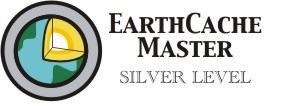This is an EarthCache and does not include any physical cache at the coordinates. To get credit for this cache, you will need to visit the site and answer the questions below. The trail is a 1/3 mile loop which will take you past 10 exhibits on life in the Pleistocene (Late Ice Age). One of the exhibits holds the information you need to answer the questions for this earth cache.
This site is a great example of how stratification helps geologists and archeologists discover the relative age of different rock formations and the fossils they contain. Sedimentary rocks are developed over time. The material which makes up the rocks is deposited layer-by-layer as it is brought in by wind or water to cover the layers below. These rocks are typically sandstone, limestone or siltstone. Any organic matter, which finds itself between the layers, will become a part of the rock, a fossil, over time.
Stratification is a branch of geology which is concerned with the composition, origin, age relationship and geographic extent of sedimentary rocks. The layers of rock, or other material, are laid down in horizontal planes with the older layers lying beneath the younger layers. When each layer is laid down, the material in each layer is laid down over the same period of time. Each layer is called a bedding plane. This means that each bedding plane is the same age over the area where it is found. Geologists will use material from each layer (e.g. fossils or organic material) to find the age of the layer (Wicander & Monroe, 2010).
A change in color or composition means that conditions in the area changed from the time when one layer was laid down to the next layer (Wicander & Monroe, 2010). An example of this would be a layer of grey limestone (formed under water), under a layer of red sandstone (formed on land) may be an indication of when an area of land was lifted or when a body of water was drained.
The walls of the wash, which you pass through to get to the site, are a great way to see the different layers.
This site contained mammal bones which came from kills made by the Clovis People at the site. The bones came from mammoths and other large mammals. When archaeologists work at a site, they name the different layers after places or people in the area. The layers help the archaeologists find fossils by showing them when they are getting to the fossil layer and how old the fossils are.
To get credit for this cache, answer the following questions by sending me a message. Please do not include your answers in your log for this cache. It is necessary to visit the site to find the answers. The cache coordinates are for an informational board at the site. The answers you are looking for are on that board.
What is the name of the layer where the fossils are found?
What is the name and color of the layer which tells the archaeologists they are close to finding the fossil layer?
How old, roughly, is the fossil layer?
Back where you first entered the wash, how deep would you need to dig to get to the fossil layer?
Describe the color of the indicator layer and the color and composition of the fossil layer.
Pictures from the site are always appreciated, but pictures in which it is possible to read the informational board, or tell the exact depth or width of the layers, will be deleted.
Wicander, R. W. & Monroe, J. S., (2010). Historical geology: Evolution of earth and life through time. 6th ed. Belmont: Brooks/Cole.
| I am a proud |
 |
